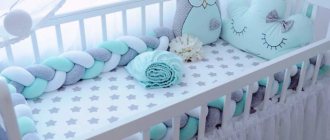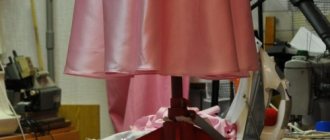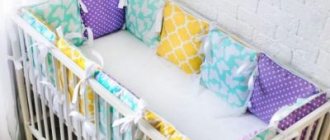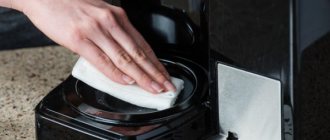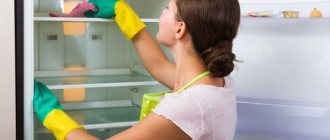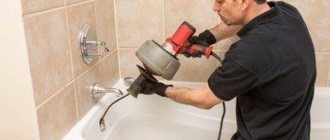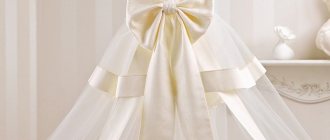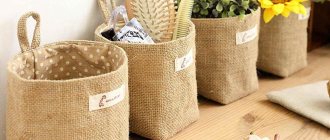You can buy bumpers for your baby's crib at any children's store. This accessory became popular back in the Soviet years and has not lost its relevance to this day. At the same time, making bumpers for a baby crib with your own hands is not so difficult. The main thing is the desire of the parents themselves to decorate the space of the cradle. The stores have enough materials for sewing and decorating such products.
The article shows how to sew bumpers for a child, what models you can choose and how to decorate. The accessory is not only attractive, but also practical. It prevents the baby from getting injured and adds comfort to the interior.
DIY bumpers for a baby crib
Side functions
The frame of children's beds made of metal and wood is quite rigid. The side parts often consist of beams. Light enters through the holes in the crib. A small hand or foot of a newborn can get there, which also adds to the concern of young parents. The solution in both cases is to protect the sides of the cradle. A special bumper with filler acts as a limiter and becomes a buffer between the baby’s cozy world and the outside environment.
An additional function of the sides is educational. You can place interesting pictures on them, add educational motifs to decorative elements, and equip baby accessories with squeakers, rustling sounds, moving and musical parts.
Star pillow attracts baby's attention
When choosing a crib, it is recommended to take into account several factors: the practicality and safety of the material and design, the appearance and functionality of the product. Modern manufacturers offer a wide range of models to suit every taste and budget. The round crib has become especially popular lately.
Product care
It is not recommended to sew the sides, as the product requires constant care at frequent intervals. What you need to do to keep the product clean:
- Washing is done at least once every 7 days. Only covers can be wet cleaned, and the base with the filler is well ventilated and dust is knocked out.
- After complete drying, double-sided ironing is carried out at high temperatures.
- In addition to washing, the product must be ventilated once a week.
Important! For washing, use only baby powders and fabric softeners.
Caring for soft sides
When choosing detergents, washing and ironing modes, you need to take into account recommendations related to the care of the type of fabric. The material may lose color, the texture may deteriorate, and defects may appear.
Child's age and bumper type
Ideas for arranging the internal contents of a crib are determined based on the needs of the child.
Protection in the form of sides can be full or partial. The first covers all sides of the crib, the second protects the child on the right and left. The age of the baby in this case is the main indicator affecting the density of the structure.
Pillows for sides, which can later be used in the nursery
Solid sides are ideal for active babies who explore the world and are able to move around the perimeter of the bed, but are not suitable for a newborn who wants to explore what is happening around them.
Which models are suitable for home sewing?
There are removable sides for the crib, which are mounted in the form of a dense rectangular piece on the side. The work requires reliable material, which is not always easy to find. In addition, it is worth taking care of fixation - this may require complex structural elements or rare fittings
In general, vertical removable parts for sidewalls are more convenient, but they are not so easy to make at home.
Borders for a newborn's crib
Non-removable sides are ideal for DIY sewing. They are either placed in the crib as an insert, or tied to it with ribbons, fastened with buttons, etc. Sewing a non-removable buffer is easier, since it is based on a filler and a cover. Such models are universal and do not require special materials, complex tools or skills. They can be decorated to your taste. A huge selection of fabrics and decorative elements, the ability to use several types of covers for the interior - all this gives room for imagination and creates a unique, inimitable atmosphere in the nursery.
Sewing bumpers for a baby crib is usually not difficult. They do not require intricate cutting. The parts are cut out according to the standard, or based on the dimensions of the crib, if its dimensions are far from those presented in the store.
Types of fixed sides
Protective soft fencing can be classified into several categories. The choice is strictly individual. At the same time, there are many types of fences with filler.
According to the degree of density, crib restraints are:
1. Solid - such bumpers are presented in the form of fabric stretched around the entire perimeter, or in the form of similar parts with a soft filler.
Solid side for crib
2. Composite - a bumper in this category consists of interconnected parts (they can also be of varying degrees of softness), the advantage of which is their multifunctionality (pillows, for example, can be used not only as part of the bumper, but also for their intended purpose).
Depending on the presence of additional elements, there are simple crib guards and decorated ones. For a small child, it is advisable to think through the decorative component so that the side serves not only as an element of safety, but also develops the baby’s visual reactions.
The limiter may have a bottom. It can also consist solely of sidewalls. It is advisable to make the choice of one design or another based on the temperature conditions in the room. If the apartment or house is quite cold, a dense base filled with insulation will be a good choice. The side parts of the side will be attached to it.
Soft side without bottom
The bumper, which is sewn to a dense base, allows less air flow for the child, but in the warm season and hot heating season this can negatively affect his well-being. In addition, a fence that is too dense can interfere with the child's ability to explore the world, completely obstructing his view.
Before cutting, it is necessary to take into account the configuration of the bumper that is supposed to be used:
3. Pillow sides - can be with or without removable covers; The main requirement for pillows is the absence of small parts in fasteners and other elements that the baby can accidentally pull into his mouth and swallow.
Pillow sides can be found both in standard beds and in extension beds. In the latter case, cutting and sewing are carried out with less material consumption.
Traditional cushion design
4. High soft barriers - the design blocks the view, despite the good protection of the baby from impacts and falls.
High bonbon sides
5. Low-height sides are the complete opposite of the previous option; they require a more attentive attitude to the safety of the child.
An alternative to the previous option is a low side
6. Bumper with pockets - the internal filling will always attract attention, so this configuration will educate and develop the little inhabitant of the crib, but at the same time it can overstimulate.
7. Fences in the form of rollers - this option can be used as an alternative to pillows.
Side bed rails in the form of pillows
How to sew sides for a nautical-style crib with your own hands.
Prepare everything you need. Fabric of the appropriate color, filler, measuring tape and a sewing machine with threads to match the color of the fabric.
Take fabric in different colors. Pre-wash.
- Cut squares from different fabrics measuring 30*30cm. There will be 48 pieces in total.
- Made from fabric of the same color, 4 strips 60*10. And two strips of fabric measuring 11*120cm.
- Sew the squares together. Two wide and four long. There should be 4 such rectangles. And 2*2 squares. There are also 4 of these.
- We sew two rectangles on three sides, insert the filler, and sew the fourth side. We sew along the squares so that the filler does not roll down.
- We do the same with the second rectangle and squares.
- We sew ties from the remnants of the fabric. Strips of fabric are 5 cm wide and 20 cm long.
- We sew prepared strips of fabric and ties to the upper part of the resulting sides.
- 8. Wash and iron. We attach it to the crib.
Such bumpers will become exclusive. Accessorize them if desired. Bumpers sewn with mother's love will make the baby's nest cozy and calm. You can also sew a bedspread or blanket for your baby.
Bumper fillers
If you have decided to use soft parts in the design of the guard, you should think about the inside and choose one of the following types of natural or artificial fillers:
Table 1. How to fill the crib restraints
| Natural ingredients | Artificial materials |
|
|
Features of fillers
An interesting idea is to use not only soft fabrics, but also dry herbs as filling.
Table 2. Impact of aromas on a child
| Herbs | Impact on well-being |
| Lavender | Normalizes the functioning of the nervous system, gives peace, improves sleep, eliminates excessive emotionality and tearfulness |
| Fennel | Eliminates anxiety, relieves abdominal cramps |
| Bergamot | Treats anxiety, helps fight viruses, is good for skin with rashes |
| Hop | Calms, improves sleep |
| Rose | Stabilizes the nervous system, improves immune function |
| Chamomile | Relieves pain, spasms, antiviral |
You can use the above herbs in their pure form and in various proportions. As a result, the child will sleep better, be capricious and get sick less.
Herbs in a case - pleasant aroma and benefits for the body
Materials for the outer part of the bumper
To ensure that the covers are well ventilated, they can be made of linen or thick calico.
The main requirement is that the threads of the woven material must be tightly intertwined, securely connecting to each other and creating a barely noticeable relief. A fabric that is too smooth will be uncomfortable for the child.
In general, it should be said that choosing fabric for children's clothes is a responsible matter. Any specially processed cotton is used to sew covers. But not every cotton fabric is suitable for sewing an accessory for a crib. Chintz, for example, leaves lint that can cause allergic reactions. Canvas has a similar disadvantage. Moreover, it is too tough.
Satin may be too slippery. If you use elements of denim when sewing protective sides, they may turn out to be rough for the delicate skin of the child’s hands and feet.
Different types of fabrics for sewing
The outer parts of the sides can be made of anything. But you should avoid silk, satin and 100% synthetics. Compared to cotton, these materials offer a lot of stretch. The outer part of crepe-satin can be stitched with propylene - this prevents unraveling. It is also better not to use allergenic wool for the outside of the bumper.
Sides made of crepe-satin are the outer part, which can serve as decoration when the child is awake
Before cutting any model, the fabric should be washed and ironed.
The color of the material is also an important element. The general rule is that shades should be dim and unsaturated. Warm or neutral colors are preferable. This is due to the color perception that is available to the baby.
A successful and moderately contrasting combination of colors in a crib
Due to his age, he is able to accept not all visual images well, but only certain tones of the picture.
The dominance of one color in the side of the crib, as well as the presence of too bright color spots in the decoration, which overload the fragile psyche, is wrong. As a rule, certain color combinations that should not be used are perceived as too catchy.
Unacceptable color combinations for baby bed bumper
Textile
Excellent quality fabrics:
- Calico;
- Flannel;
- Chintz;
- Cotton silk;
- Linen.
When choosing a product, remember its intended purpose. Choose your textiles carefully. Genuineness is the most important indicator. Prefer environmentally friendly, anti-allergenic fabric that can be instantly tidy even after washing in the washing machine and can be dried quickly.
The best option is subtle shades. A contrasting color will most likely be a source of irritation for the baby.
Attachments for child side boards
The sides can be attached to the crib using ties or Velcro. For fastenings, you should not choose smooth ribbons - for example, satin. They can easily fall off, in which case the child may be injured.
Separately, you should consider the features of the ties - any other method of placing the sides in the crib is more difficult to implement, and its elements can, moreover, harm the child.
Short sewn ties are only suitable if they are made on pillows. By connecting such elements in pairs, you don’t have to worry about the collapse of the structure. A reliable option are flip-over ties that need to be sewn in. Reversible fastenings can be additionally equipped with Velcro.
It is better to decide on the fastening method in advance - the sewing pattern depends on this
Need for protection
The popularity of enclosing covers entered the interior not so long ago. The flattened arms, fixed across the cradle, form a partition that allows your baby to protect himself from bruises and other injuries.
Using the edge of the bed, it is possible to create a play corner with maximum comfort for your child, and adults will not have to worry about their security.
Decorating the sides
In order to give the sides that protect the child from injury an attractive look and create a truly original product, you can use many finishing options.
Soft parts are decorated with felt appliqués or cotton fabric stripes.
It is important that the decorative elements are securely sewn to the base. Otherwise, the child may tear them off and harm himself.
You can make your own patches or purchase ready-made ones.
One of the decorative options is special stickers, which are sold in hardware departments or furniture stores. They do not leave sticky marks on the surface and can be successfully used on fabric bases.
Adhesive-based applications have similar functions. The only difference is that they cannot be removed easily. But there is also a plus - the adhesive applications are securely fixed to the fabric of the protective sides.
We must remember that a baby’s bed is not a place for small rhinestones, beads and other elements that can be easily detached.
Adhesive parts adhere firmly to the fabric base
When decorating children's things, you can use any ideas. The main thing to consider is the degree of security of a particular element.
If you are not from Russia, then follow the link to buy patterns
https://www.etsy.com/shop/MaranisBabyPattern?ref=l2-about-shopname
Hello, this is the Maranis company. In this article we will look at how to sew the sides of an animal with your own hands.
These soft pillows are ideal for a newborn's crib and will give it a great look. They also have a functional affiliation:
- They will protect the baby from injuries from the bed bars.
- Will protect from wind and drafts.
- They will be true friends for the entire period of the baby’s growing up. He will quickly begin to understand what this or that animal looks like.
We will teach you how to sew animal bumpers into a crib for a bunny, fox, cat, dog, moose, owl, unicorn, fish, sheep, hedgehog, pig, dragon. This is not difficult to do if you have at least some seamstress skills. All you need is an ordinary household sewing machine, fabrics and a great desire to do something with your own hands.
But we will need patterns which you can find by following the link:
